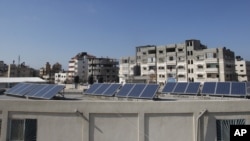Scientists from Harvard University and IBM Corporation plan to use the down time of thousands of personal computers in search of the next generation of solar cell materials.
Researchers with the Clean Energy Project will ask volunteers from IBM's World Community Grid to create a "virtual supercomputer" for studying millions of chemical compounds in order to to identify those suitable for harvesting the sun's energy more efficiently.
U.S. computer giant IBM already has what is called the World Community Grid, a network of private computers worldwide, which can be employed for scientific research when not in use by their owners - for instance during the night.
The Clean Energy Project has collected about 2.3 million candidate compounds for organic voltaic cells, which can be accessed free online.
The biggest hurdle for much wider use of solar cells is their relative low efficiency of around 19 percent for standard commercial silicone cells. Other materials are more efficient but the cost is prohibitive.
Harvard scientists hope to be able to find new organic based materials that will be more efficient and at the same time cheaper to manufacture and install.
Volunteers in the World Community Grid already help scientists with projects such as the fights against AIDS, childhood cancer and malaria.
Researchers with the Clean Energy Project will ask volunteers from IBM's World Community Grid to create a "virtual supercomputer" for studying millions of chemical compounds in order to to identify those suitable for harvesting the sun's energy more efficiently.
U.S. computer giant IBM already has what is called the World Community Grid, a network of private computers worldwide, which can be employed for scientific research when not in use by their owners - for instance during the night.
The Clean Energy Project has collected about 2.3 million candidate compounds for organic voltaic cells, which can be accessed free online.
The biggest hurdle for much wider use of solar cells is their relative low efficiency of around 19 percent for standard commercial silicone cells. Other materials are more efficient but the cost is prohibitive.
Harvard scientists hope to be able to find new organic based materials that will be more efficient and at the same time cheaper to manufacture and install.
Volunteers in the World Community Grid already help scientists with projects such as the fights against AIDS, childhood cancer and malaria.






